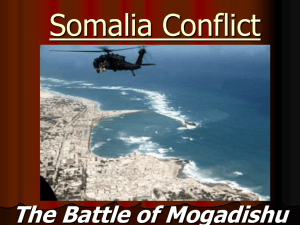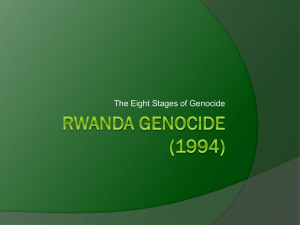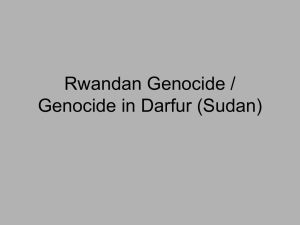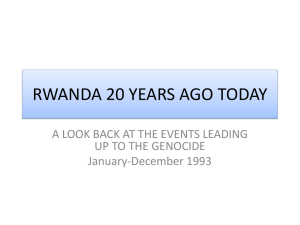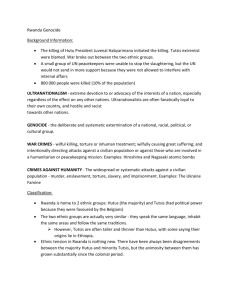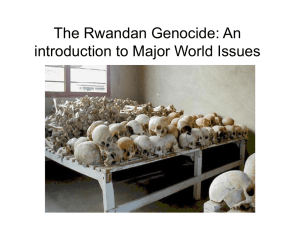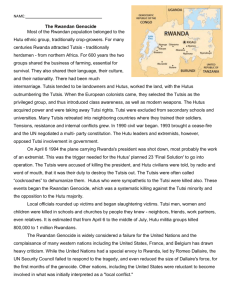Rwanda Timeline and Glossary of Terms: Timeline 1948 United
advertisement
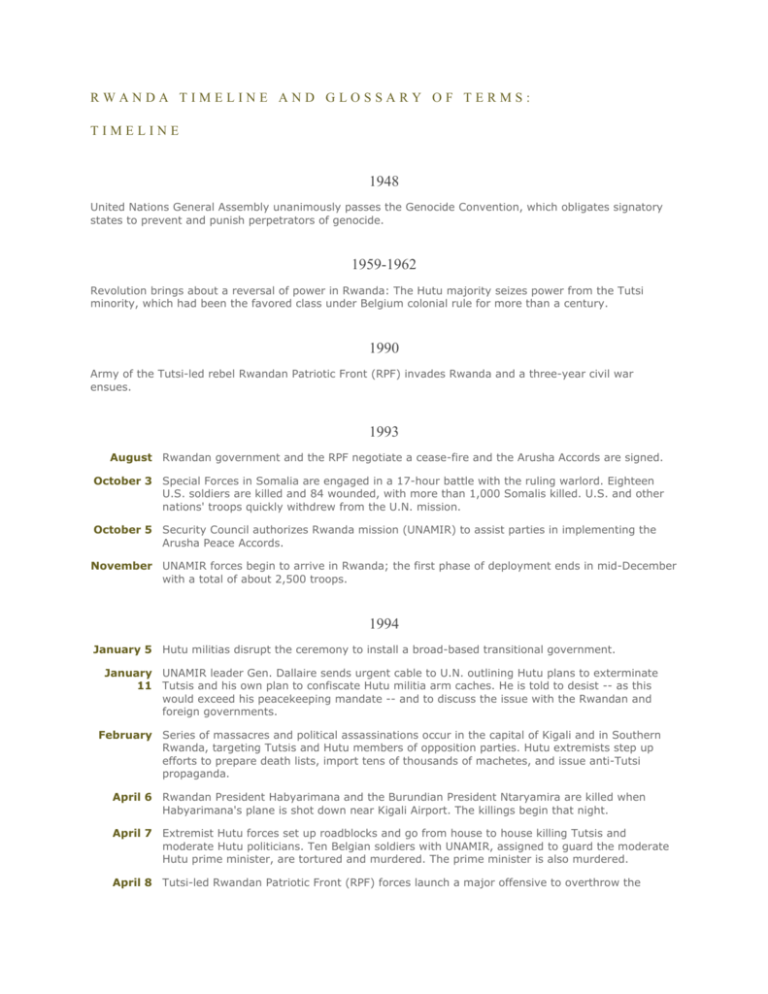
RWANDA TIMELINE AND GLOSSARY OF TERMS: TIMELINE 1948 United Nations General Assembly unanimously passes the Genocide Convention, which obligates signatory states to prevent and punish perpetrators of genocide. 1959-1962 Revolution brings about a reversal of power in Rwanda: The Hutu majority seizes power from the Tutsi minority, which had been the favored class under Belgium colonial rule for more than a century. 1990 Army of the Tutsi-led rebel Rwandan Patriotic Front (RPF) invades Rwanda and a three-year civil war ensues. 1993 August Rwandan government and the RPF negotiate a cease-fire and the Arusha Accords are signed. October 3 Special Forces in Somalia are engaged in a 17-hour battle with the ruling warlord. Eighteen U.S. soldiers are killed and 84 wounded, with more than 1,000 Somalis killed. U.S. and other nations' troops quickly withdrew from the U.N. mission. October 5 Security Council authorizes Rwanda mission (UNAMIR) to assist parties in implementing the Arusha Peace Accords. November UNAMIR forces begin to arrive in Rwanda; the first phase of deployment ends in mid-December with a total of about 2,500 troops. 1994 January 5 Hutu militias disrupt the ceremony to install a broad-based transitional government. January UNAMIR leader Gen. Dallaire sends urgent cable to U.N. outlining Hutu plans to exterminate 11 Tutsis and his own plan to confiscate Hutu militia arm caches. He is told to desist -- as this would exceed his peacekeeping mandate -- and to discuss the issue with the Rwandan and foreign governments. February Series of massacres and political assassinations occur in the capital of Kigali and in Southern Rwanda, targeting Tutsis and Hutu members of opposition parties. Hutu extremists step up efforts to prepare death lists, import tens of thousands of machetes, and issue anti-Tutsi propaganda. April 6 Rwandan President Habyarimana and the Burundian President Ntaryamira are killed when Habyarimana's plane is shot down near Kigali Airport. The killings begin that night. April 7 Extremist Hutu forces set up roadblocks and go from house to house killing Tutsis and moderate Hutu politicians. Ten Belgian soldiers with UNAMIR, assigned to guard the moderate Hutu prime minister, are tortured and murdered. The prime minister is also murdered. April 8 Tutsi-led Rwandan Patriotic Front (RPF) forces launch a major offensive to overthrow the interim government, reigniting the civil war. April 9-10 France, Belgium and Italy send troops to evacuate their citizens. Americans leave Rwanda by convoy to Burundi, where U.S. Marines wait. A handful of Rwandans escape with the Westerners. April 14 One week after the murder of the 10 Belgian soldiers, Belgium begins to withdraw forces from UNAMIR and urges the U.S. to support pulling out the rest of the peacekeepers. April 21 The U.N. Security Council votes unanimously to withdraw most of the UNAMIR troops, cutting the force from 2,500 to 270. May 17 The U.N. finally agrees to send 5,500 troops to Rwanda; however full deployment will not be complete until September--long after the genocide is over. Mid-May The International Committee of the Red Cross estimates 500,000 Rwandans have been killed. Mid-July Tutsi-led RPF forces capture Kigali. The Hutu government flees to Zaire, followed by a tide of refugees. The RPF sets up an interim government of national unity in Kigali. The genocide is over. An estimated 800,000 Rwandans have been killed in 100 days. November Recognizing that serious violations of humanitarian law were committed in Rwanda, the 8 Security Council creates the International Criminal Tribunal for Rwanda (ICTR). 2002 April 2 Colonel Theoneste Bagosora and three other alleged architects of the genocide go on trial at the ICTR; as of February 2004, their trial is still underway. GLOSSARY Arusha Accords: Intended to end a three-year civil war between Rwanda's Hutu government and Tutsi-led RPF rebels, the August 1993 peace agreement called for a democratically elected government with a broad-based transitional government leading to the elections. Hutu extremists feeling marginalized by the agreement orchestrated the genocide. Genocide: The deliberate and systematic extermination of a national, racial, political, or cultural group. Hutu: The majority community in Rwanda, which during the colonial period had suffered as second-class citizens. With independence, Hutu gained power and privilege through the patronage of presidents Gregoire Kayibanda and Maj. Gen. Juvenal Habyarimana. Interahamwe: Youth militia of the Hutu extremists trained by organizers to carry out the genocide. International Committee of the Red Cross (ICRC): A global humanitarian aid organization, the ICRC estimates it saved as many as 70,000 Rwandans targeted by the genocide without the use of force or weapons. Rwandan Armed Forces (FAR): Army of the Hutu government led by President Habyarimana. After the president's plane was shot down, the FAR joined the Presidential Guard and the interahamwe in carrying out the genocide. Rwandan Patriotic Front (RPF): Tutsi-led rebels who fought the Hutu leadership during the Rwandan civil war. While the international community refused to intervene and 800,000 Tutsis were killed, the RPF was finally successful in putting down the Hutu extremists and ending the genocide. Tutsi: Rwanda's largest minority community, which Belgian colonials had favored as the privileged class until Hutu revolutionaries took over political leadership in the early 1960s. Transitional Government: Ruling political body of shared Hutu and Tutsi leadership negotiated by the Arusha Accords. UNAMIR: The United Nations peacekeeping force brought in to support the Arusha Accords' transition process. Two weeks into the genocide, the U.N. Security Council voted unanimously to withdraw most of the UNAMIR troops, cutting the force from 2,500 to 270.
